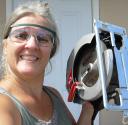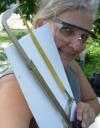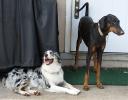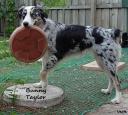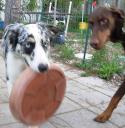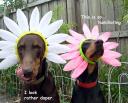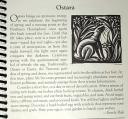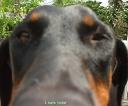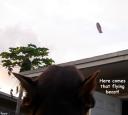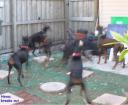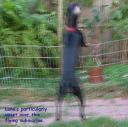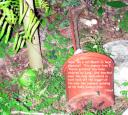Evolution and the Ethics and Empathy of Dogs
While stuffing Kongs yesterday, one of the NPR shows I listened to was Weekend America. There is a segment called “Good News, Bad News, No News,” where the announcer reads a story and three journalists on the panel comment if they think the story is worthy of news by giving it one of the three labels. The show this week, August 23, 2008, had a story about how dogs have learned ethical behavior from humans. A team of reasearchers in Budaphest made this discovery back in 2000 or 2003! There should be a fourth category to this game – old news! Of course, the panel poo-pooed the idea, being they are probably fearful that a dog could eventually if not already hold higher ethics than the press itself. I already see a great decrease in human empathy as I have matured from one decade to the next. My dogs are much more empathetic than many people I run into in this area of the world. Call me jaded.
I searched on the Internet for some information at the root of this discovery. Below are a couple of sources I found. This is very interesting. Luigi, for one, oftentimes looks at me when he is in a bind with one of his toys, or if his Kong is on the counter out of reach. Or he’ll bark to call me in from another room, then I will ask him “What’s wrong,” and he’ll look at the problem, and bark to tell me he needs help fixing it.
ALMOST HUMAN
Has Evolution Taught Our Dogs New Tricks?
LONDON (Reuters)—Thousands of years of joint evolution have made man’s best friend into one of the family, an article in the journal New Scientist said on Wednesday [1 March 2000]. Research even indicates that dogs could empathize with the emotions of people who were sad or ill. Research carried out by scientists in Budapest indicates that dogs develop bonds with their owners as children do with their parents, the journal said. “What we found is that just as babies display a variety of levels of attachment towards their parents, dogs also show different levels of attachment to their owner,” Adam Miklosi of the Eotvos Lorand University in Budapest told Reuters. A study called the “strange situation test” demonstrates that babies are happy to explore a new environment as long as their mother is nearby but become anxious if she leaves. Miklosi found the same behavior in dogs. In 1997, researchers in the United States used DNA techniques to estimate that dogs may have been domesticated as long as 135,000 years ago—previously scientists had thought dogs became domesticated only 14,000 years ago. Thousands of years of co-existence have influenced dogs to become dependent on humans, Miklosi said in the New Scientist article. “The stronger the attachment between a dog and its owner . . . the more likely the pet was to behave in a socially dependent way, relinquishing its powers of independent thought and action,” the New Scientist said. Selective breeding of dogs over time has produced animals that form strong bonds and are predisposed to learn and obey rules, New Scientist said. “The dog’s natural environment is the human family or other human social settings,” the head of the Budapest team, Vilmos Cysani, said in the magazine article. Prolonged exposure to humans has also made dogs more responsive to human gestures than other animals which are purportedly more “intelligent” such as chimpanzees, the journal said. For instance, dogs are even better than chimpanzees at interpreting gestural clues and seem to understand what a human means when he points somewhere. Chimpanzees cannot, Miklosi said, though he pointed out long exposure could change that. More controversially, Cysani said his team’s research indicates dogs could empathize with the emotions of people who were sad or ill. He even goes so far as to compare canine bonding with human love, New Scientist said.
——————–
How Did He Learn to Speak Volumes With a Look?
By Rob Stein
Washington Post Staff Writer
As any poodle, spaniel or mutt owner knows, dogs have an uncanny ability to read human body language, whether it’s following a finger pointing the way to an errant tennis ball or spotting a glance that signals an imminent trip to the park.
But animal behavior experts have debated for years how much of this dogged perceptiveness is inborn and how much is learned by being raised around humans. New research, however, indicates that the capacity to communicate with humans silently through gestures and glances has become an inborn talent as a result of the thousands of years that dogs have lived, worked and played with people.
“They don’t speak like we do. But there is communication,” said Adam Miklosi of Eotvos University in Budapest.
Miklosi is among researchers around the world who have been working to gain a better understanding of the talents displayed by man’s best friend. Most recently, Miklosi and his colleagues conducted a unique experiment to try to tease out exactly how much of the capacity to interpret humans’ subtle signals is instinctive.
“People usually assume that dogs got more stupid because humans provided everything. All they have to do is lie back and enjoy life,” Miklosi said. “What we think is that dogs went through a re-evolution that started from some sort of wolflike animals. . . . They acquired skills that make them adaptive to the human environment. They interact with humans. They learn from humans.”
To test his ideas, Miklosi and his colleagues designed an experiment comparing dogs with their closest relatives — wolves. They took 13 wolf pups from their mothers when they were just four or five days old and raised them in human homes just like puppies. As adults, the wolves received intensive contact with their human caretakers, who literally carried the animals with them wherever they went.
Previous studies had shown that adult dogs were better than adult wolves at reading human body language. But it was unclear how much of that was inborn and how much dogs learned growing up around humans. This experiment was aimed at clarifying that point.
“The wolves got more human contact than the ordinary dogs got from their owners,” Miklosi said in a telephone interview. “They were really thrown into the human environment.”
The researchers then trained the wolves and various breeds of dogs to get a piece of meat by pulling on a string. After the animals learned how to get the meat, the researchers attached the string so that no matter how hard the animals pulled they could not get the meat.
The wolves just continued to pull on the string in frustration. But the dogs quickly stopped pulling when the string did not move and turned to look at the faces of the humans, the researchers reported in the April 29 issue of the journal Current Biology.
“The dogs gave up much earlier. They were, very quickly, looking at the humans, the owners, looking at their faces,” Miklosi said. “That is what is interesting. That never happened with the wolves. They just kept pulling. But the dogs, what they did was basically look at the owners. If you observe this as a human, you would describe it as an asking-for-help gesture.”
The experiment shows that “the dogs have adapted to use this channel” of communication, Miklosi said. “This has provided the opportunity to communicate with us. And the wolves have not,” he said.
“The dogs have learned our language, to some extent. So we don’t need to learn dog language. They can use our channels of communication, like vision,” Miklosi said. “You can point for a dog and communicate with it. You can point for a wolf, but it won’t understand what you are doing.”
Brian Hare of Harvard University, who previously conducted a similar experiment that showed dogs were superior to chimps and wolves at reading human gestures, said the results show that “dogs really understand that humans are their partners in life. They can elicit their help and use them as a kind of tool.”
“Wolves don’t know that. They keep trying to solve it on their own. It’s something that’s programmed into their genes,” Hare said. Hare is planning a follow-up experiment to try to determine why dogs are so much better at reading human cues.
“It could be that because there was selection for dogs that are smart — dogs that can read human cues and figure out what they want,” Hare said. “Those were the ones that survived and passed their genes on.”
But another possibility is that dogs’ ability is a byproduct of domestication. Hare tells the story of foxes that were domesticated in Siberia 50 years ago. Over the generations, the foxes developed physical changes, including floppy ears, curly tails, different colorings and smaller teeth and jaws.
The human caretakers of the foxes “weren’t trying to create any of those changes. They were just trying to get friendly foxes. But when they bred them together they got these changes as byproducts,” Hare said.
So, for dogs, “the alternative is that when dogs were domesticated,” the capacity to pick up cues from humans “was just an accident — just like the floppy ears,” Hare said.
Hare plans to compare the domesticated foxes with dogs to try to find out. “If they perform like dogs on the test, then we know it’s likely the dogs also changed as a byproduct,” Hare said.
“The question is: How did the evolution happen? It’s very rare that you can actually demonstrate what the selection pressure was,” Hare said. “That’s why this is so exciting. We’re going to take a big step towards solving a mystery.”
Marc Bekoff, a dog behavior researcher at the University of Colorado in Boulder, said that Miklosi’s experiment shows that “dogs aren’t just dumbed-down wolves.”
“A lot of people think that domesticated animals, when compared to wilder animals, aren’t as smart,” Bekoff said. “It shows that species adapt to the social niche in which they live. And the social niche for a dog would be its human companions.”
Bekoff said this ability probably helps explain the sense that many dog owners have that their animals empathize with their emotions. Dogs can pick up the subtle physical clues that signal what their human companions are feeling, whether it’s happiness, sadness, anxiety or anger.
“I think part of the reason there is this strong bond between dogs and humans is because we are empathetic to them and they show empathy to us,” Bekoff said.
“We can never know for sure. But I’ve done a lot of work on animals’ emotions. Animals and humans share a lot of the same neurological structures and the same neurochemistry. I think it’s really dog empathy.”



